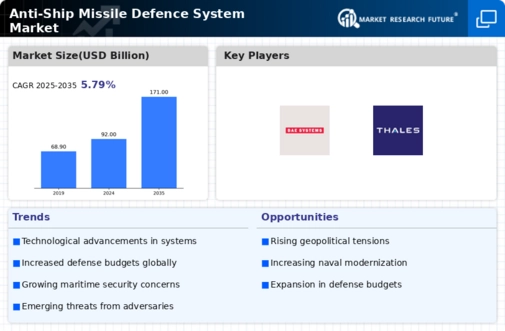Market Share
Anti-Ship Missile Defence System Market Share Analysis
The US Anti-Ship Missile Defense System Market is a crucial segment within the defense industry, reflecting the nation's commitment to safeguarding its maritime interests and ensuring security against potential threats from adversaries. This market overview delves into the landscape of anti-ship missile defense systems, highlighting key players, market drivers, challenges, and future trends.
At the forefront of the US anti-ship missile defense system market are established defense contractors such as Lockheed Martin, Raytheon Technologies, Boeing, and Northrop Grumman. These companies leverage their expertise in advanced technologies, including radar systems, missile interceptors, and command and control networks, to develop and deliver cutting-edge solutions for maritime defense.
The increasing proliferation of advanced anti-ship missiles by potential adversaries poses a significant threat to US naval assets and commercial shipping lanes. In response, the demand for robust anti-ship missile defense systems has surged, driving market growth. These systems employ a combination of sensors, interceptors, and defensive strategies to detect, track, and neutralize incoming threats, thereby enhancing the survivability of naval vessels and maritime assets.
One of the primary drivers fueling market expansion is the growing emphasis on maritime security and the need to protect critical sea lanes vital for global trade and commerce. As geopolitical tensions escalate in regions such as the Indo-Pacific and the Middle East, navies worldwide are investing in advanced anti-ship missile defense capabilities to deter potential aggressors and ensure freedom of navigation.
Furthermore, technological advancements in sensor fusion, artificial intelligence, and directed energy weapons are reshaping the landscape of anti-ship missile defense systems. Integrating these innovations enables more efficient threat detection and response, enhancing the overall effectiveness of maritime defense operations.
However, the US anti-ship missile defense system market also faces several challenges that warrant attention. Chief among these is the escalating cost of developing and maintaining sophisticated defense capabilities. Budget constraints and competing defense priorities may limit the resources available for investment in anti-ship missile defense programs, potentially hindering market growth.
Moreover, the evolving nature of asymmetric threats, including unmanned aerial vehicles (UAVs) and hypersonic missiles, presents new challenges for existing anti-ship defense systems. Addressing these emerging threats requires continuous innovation and adaptation to stay ahead of adversaries.
Looking ahead, the US anti-ship missile defense system market is poised for steady growth driven by ongoing modernization initiatives and the imperative to counter evolving maritime threats. Investments in next-generation technologies, including directed energy weapons, unmanned platforms, and autonomous systems, are expected to shape the future landscape of anti-ship missile defense capabilities.






Leave a Comment